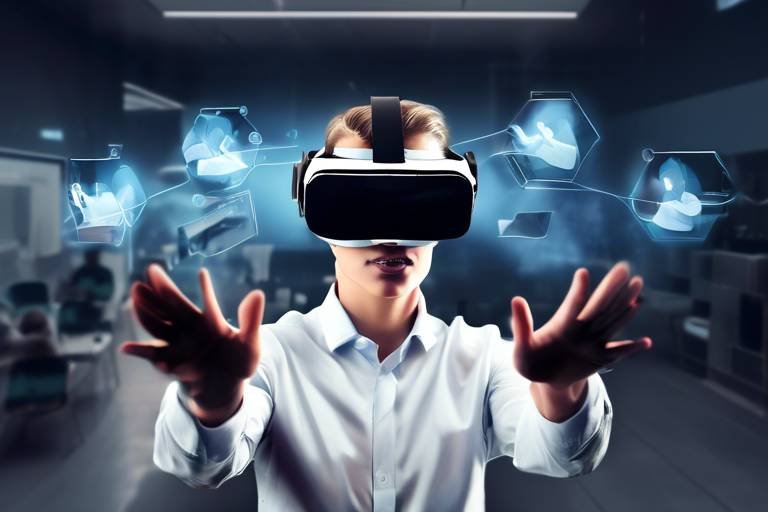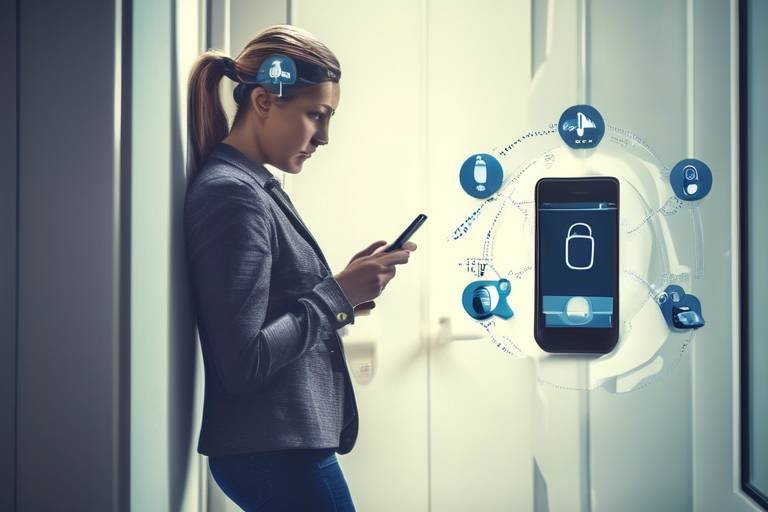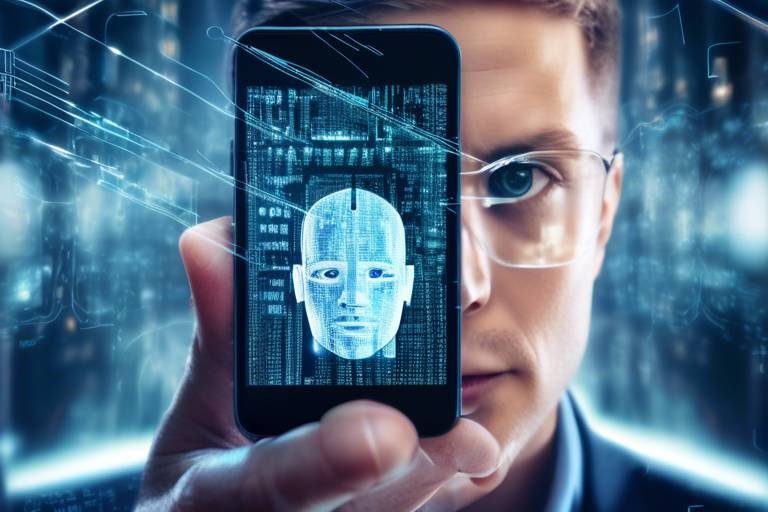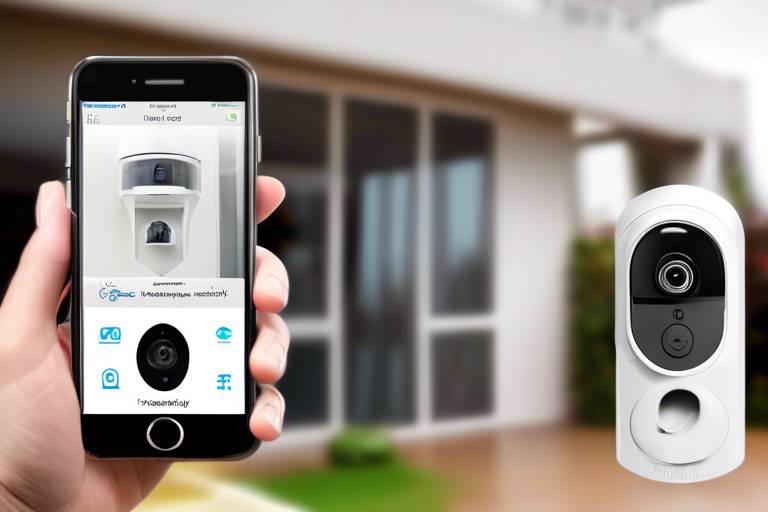The Role of Virtual Reality in Employee Training
In today's fast-paced world, the way we train employees is undergoing a remarkable transformation, thanks to the advent of Virtual Reality (VR) technology. Imagine stepping into a different world where you can practice your skills without the fear of making mistakes. That’s what VR offers – an immersive experience that not only enhances engagement but also revolutionizes the way we approach learning and development in the workplace. With VR, training isn't just about sitting in a classroom or watching a video; it’s about diving into realistic simulations that mirror the real world.
The magic of VR lies in its ability to create realistic environments where employees can learn, practice, and hone their skills. Whether it's a medical professional practicing a complex surgical procedure or a factory worker learning to operate heavy machinery, VR provides a safe space to experiment and make mistakes without any real-world consequences. This kind of training is not only engaging but also significantly improves knowledge retention. After all, when employees are actively involved in their learning process, they are more likely to remember what they've learned.
Furthermore, the potential applications of VR in employee training are vast and varied. Industries such as healthcare, manufacturing, and emergency services are already reaping the benefits. In healthcare, for instance, VR allows medical students to interact with virtual patients, enhancing their communication skills and empathy. In manufacturing, employees can familiarize themselves with intricate machinery in a controlled, virtual environment, which reduces the likelihood of accidents on the job. The possibilities are endless, and as technology continues to advance, we can expect even more innovative uses of VR in the training landscape.
As organizations look to invest in VR training solutions, they are not just enhancing the learning experience for their employees; they are also paving the way for a more skilled and efficient workforce. The future of employee training is here, and it’s virtual!
- What is Virtual Reality training?
Virtual Reality training uses immersive technology to create realistic simulations for employees to practice their skills in a safe environment. - How does VR improve employee engagement?
VR provides interactive and immersive experiences that capture employees' attention and make learning more enjoyable. - Is VR training cost-effective?
Yes, by reducing the need for physical materials and minimizing training downtime, VR can lead to significant cost savings for organizations. - Which industries are using VR for training?
Industries such as healthcare, manufacturing, and emergency services are leading the way in adopting VR training solutions. - What are the future trends in VR training?
Future trends include AI integration for personalized learning experiences and more advanced immersive technologies.

Benefits of VR in Training
Virtual reality (VR) is not just a buzzword; it's a game-changer in the realm of employee training. Imagine stepping into a world where you can practice your skills in a safe, controlled environment that mimics real-life scenarios. That's precisely what VR offers! The immersive experiences provided by VR are unparalleled, allowing employees to engage with their training material in ways that traditional methods simply can't match. This level of engagement is crucial because it keeps learners focused and motivated, making the training process not just effective but also enjoyable.
One of the standout benefits of VR in training is its ability to simulate real-world scenarios without any associated risks. For instance, consider a healthcare professional learning to perform a complex surgery. With VR, they can practice repeatedly, honing their skills until they feel confident enough to perform the procedure in real life. This type of training is invaluable, as it not only enhances skill acquisition but also significantly reduces the likelihood of errors when it matters most.
Moreover, VR training can cater to various learning styles. Some learners thrive in visual environments, while others prefer hands-on experiences. VR bridges this gap by offering a multisensory approach that engages sight, sound, and even touch. This adaptability ensures that every employee can benefit from the training, leading to improved retention rates. In fact, studies show that learners are more likely to remember what they've practiced in a VR setting compared to traditional methods, which often rely heavily on passive learning.
Another compelling advantage is the flexibility that VR training provides. Employees can engage in training sessions at their convenience, without the need to travel or disrupt their work schedules. This flexibility not only enhances productivity but also allows organizations to train larger groups simultaneously, maximizing resource utilization. With VR, training can be scaled up or down depending on the organization's needs, making it a highly adaptable solution.
In summary, the benefits of VR in training are immense. From creating immersive, risk-free learning environments to accommodating diverse learning styles and schedules, VR is reshaping how organizations approach employee development. As companies continue to embrace this innovative technology, we can expect to see even more exciting advancements that will further enhance the training experience.

Applications Across Industries
Virtual reality (VR) is making waves across a multitude of sectors, revolutionizing the way employees are trained and prepared for their roles. Imagine stepping into a world where you can practice your skills without any real-world consequences—that's the power of VR! It's not just a gimmick; it's a game-changer that offers immersive experiences tailored to various industries. From healthcare to manufacturing, organizations are harnessing this technology to create realistic simulations that enhance skill development and operational efficiency.
In the healthcare sector, VR is particularly groundbreaking. Medical professionals can now engage in lifelike simulations that allow them to practice complex surgical procedures or navigate patient interactions. This not only enhances their technical skills but also fosters better communication and empathy—qualities that are essential in patient care. Imagine a surgeon rehearsing a delicate operation in a virtual environment where mistakes don’t have real-life repercussions. This kind of training ensures that when they step into the operating room, they are well-prepared and confident.
Moreover, VR is proving invaluable in emergency response training. First responders can be placed in high-pressure scenarios that mimic real-life emergencies, helping them improve their decision-making and teamwork skills. Picture a firefighter navigating through a burning building in a virtual simulation, learning how to react swiftly and effectively without the risk of actual danger. This kind of training can ultimately lead to better outcomes during real emergencies, saving lives and resources.
In addition to healthcare, the manufacturing industry is also reaping the benefits of VR. Employees can utilize VR to familiarize themselves with complex machinery and safety protocols. This hands-on experience is crucial, as it reduces the likelihood of accidents and enhances overall workplace safety. For instance, a factory worker can practice operating a new machine in a virtual setting, gaining confidence before ever touching the real equipment. This not only improves their skills but also ensures a safer working environment for everyone.
Furthermore, VR training can be adapted for various roles within an organization. For example, customer service representatives can practice handling difficult customer interactions in a controlled virtual space, enhancing their communication skills and emotional intelligence. This versatility makes VR a valuable tool across different job functions, ensuring that employees are not just trained but are also well-prepared for their specific challenges.
As we look to the future, the applications of VR in employee training are bound to expand even further. With advancements in technology, we can expect even more industries to adopt VR solutions, creating a more skilled and efficient workforce. The possibilities are endless, and as organizations continue to explore the potential of this innovative training method, the benefits will likely multiply.
- What industries are currently using VR for employee training?
Industries such as healthcare, manufacturing, retail, and emergency services are at the forefront of adopting VR training solutions.
- How does VR training improve employee retention of skills?
Research shows that immersive experiences in VR lead to higher long-term retention rates as employees engage in realistic simulations that reinforce learning.
- Is VR training cost-effective?
Yes, VR training can significantly reduce costs associated with physical materials, travel, and downtime, making it a smart investment for organizations.
- Can VR training be customized for different roles?
Absolutely! VR training can be tailored to meet the specific needs of different job functions, ensuring that employees receive the most relevant training.

Healthcare Training
In the ever-evolving field of healthcare, the integration of Virtual Reality (VR) technology is nothing short of revolutionary. Imagine being a medical professional standing in a virtual operating room, where every tool is at your fingertips, and every scenario is meticulously crafted to mirror real-life situations. This is not just a fantasy; it’s the reality that VR brings to healthcare training. By immersing medical practitioners in lifelike simulations, VR allows them to practice complex surgical procedures and patient interactions without the inherent risks associated with actual medical environments.
One of the most significant advantages of VR in healthcare training is the ability to conduct repetitive practice in a safe and controlled environment. For instance, a surgeon can repeatedly perform a delicate procedure until they achieve mastery, all within the confines of a virtual setting. This kind of practice not only enhances their technical skills but also boosts their confidence when facing real patients. Moreover, VR can simulate a variety of medical scenarios, from routine check-ups to rare emergencies, ensuring that healthcare professionals are well-prepared for any situation.
Furthermore, VR training extends beyond just technical skills; it encompasses vital soft skills as well. Effective communication and empathy are crucial in patient care, and VR provides a platform for healthcare providers to engage in patient interaction scenarios. In these simulations, they can practice how to deliver difficult news, handle patient anxiety, or manage family dynamics—all of which are essential components of holistic patient care. By practicing these interactions in a virtual environment, healthcare workers can refine their communication skills and develop a deeper sense of empathy, which ultimately leads to better patient outcomes.
To illustrate the impact of VR in healthcare training, consider the following table that outlines some key benefits:
| Benefit | Description |
|---|---|
| Immersive Learning | Provides realistic simulations that enhance learning and retention. |
| Risk-Free Environment | Allows practitioners to make mistakes and learn from them without endangering patients. |
| Skill Mastery | Enables repeated practice of procedures until mastery is achieved. |
| Enhanced Communication | Improves soft skills through simulated patient interactions. |
In summary, the application of VR in healthcare training is transforming how medical professionals are educated. It not only equips them with the necessary technical skills but also fosters essential interpersonal abilities. As the healthcare landscape continues to change, embracing VR technology will undoubtedly prepare practitioners to deliver the highest standard of care, ensuring that they are ready to face the challenges of modern medicine.
- What is VR training in healthcare? VR training in healthcare involves using virtual reality technology to simulate medical scenarios for training purposes.
- How does VR improve medical training? It offers immersive experiences that enhance skill retention and allows for practice in a risk-free environment.
- Is VR training effective for soft skills development? Yes, VR training can significantly improve communication and empathy through realistic patient interaction scenarios.

Emergency Response Training
In today's fast-paced world, where emergencies can strike at any moment, effective training for emergency responders is paramount. Virtual reality (VR) is stepping in as a game changer, providing responders with the opportunity to experience high-pressure situations in a safe and controlled environment. Imagine being able to practice responding to a natural disaster or a medical emergency without the actual risk involved—this is the magic of VR.
With VR technology, emergency responders can immerse themselves in realistic scenarios that replicate the chaos and urgency of real-life situations. This kind of training not only enhances their decision-making skills but also fosters teamwork and communication among team members. For instance, during a simulated fire rescue, responders can practice coordinating their actions, sharing information, and executing their roles effectively, all while under the pressure of a ticking clock. It’s like a high-stakes video game, but with real-world implications.
Furthermore, VR training allows responders to face various scenarios repeatedly, refining their skills and boosting their confidence. The ability to rehearse a range of situations—from medical emergencies to disaster response—ensures that they are well-prepared for whatever they might encounter in the field. This kind of hands-on experience is invaluable, as it bridges the gap between theoretical knowledge and practical application.
To illustrate the impact of VR in emergency response training, consider the following table that outlines key benefits:
| Benefit | Description |
|---|---|
| Realistic Simulations | Responders can practice in lifelike scenarios that mimic real emergencies. |
| Improved Decision-Making | Training under pressure enhances critical thinking and quick responses. |
| Team Coordination | Facilitates better communication and teamwork among responders. |
| Safe Learning Environment | Allows practice without the risks associated with real-life emergencies. |
Moreover, the immersive nature of VR can evoke emotional responses, further preparing responders for the psychological aspects of their jobs. They can experience the stress and urgency of a crisis, which helps them manage their emotions and reactions when faced with real-life situations. This level of preparedness can make all the difference in emergency scenarios, potentially saving lives.
In conclusion, VR is not just a technological advancement; it’s a revolutionary tool that enhances emergency response training. By providing realistic, immersive experiences, VR equips responders with the skills and confidence they need to tackle emergencies head-on. As we continue to embrace this technology, the future of emergency response training looks not only more effective but also safer for everyone involved.
- What is Virtual Reality (VR) training?
VR training uses simulated environments to provide immersive learning experiences, allowing participants to practice skills in a safe setting. - How does VR improve emergency response training?
VR enhances training by offering realistic scenarios that improve decision-making, teamwork, and emotional preparedness. - Is VR training cost-effective?
Yes, VR training can reduce costs associated with physical materials and minimize downtime during training sessions. - Can VR training be customized?
Absolutely! Many VR training programs can be tailored to fit the specific needs of different organizations and scenarios.

Patient Interaction Scenarios
In the realm of healthcare, the ability to communicate effectively with patients is paramount. in virtual reality (VR) training offer healthcare providers a unique opportunity to practice and refine these essential skills in a safe and controlled environment. Imagine being able to step into the shoes of a patient, experiencing their emotions and concerns firsthand—this is precisely what VR allows healthcare professionals to do. Through immersive simulations, they can engage in realistic conversations, navigate difficult topics, and learn how to respond empathetically to patient needs.
One of the most significant advantages of VR in patient interaction training is its ability to create a variety of scenarios that healthcare workers may encounter. For instance, a doctor could practice delivering bad news to a patient or assisting someone who is anxious about a medical procedure. These scenarios not only enhance communication skills but also foster a deeper understanding of patient perspectives. By engaging in these lifelike simulations, healthcare providers can develop crucial skills such as:
- Empathy: Understanding and sharing the feelings of patients, which is vital for building trust.
- Active Listening: Focusing fully on the patient’s words, ensuring they feel heard and valued.
- Conflict Resolution: Handling challenging conversations or disagreements with professionalism and care.
Furthermore, VR allows for immediate feedback, which can be instrumental in refining these skills. After each scenario, participants can receive evaluations based on their performance, identifying areas for improvement. This iterative learning process not only boosts confidence but also prepares healthcare providers for real-life interactions that can be emotionally charged and complex.
As the healthcare landscape continues to evolve, the need for effective patient communication becomes even more critical. With the integration of VR training, healthcare professionals are better equipped to handle the nuances of patient interactions, ultimately leading to improved patient satisfaction and outcomes. By investing in such innovative training methods, healthcare organizations can ensure their staff is not only technically proficient but also capable of providing compassionate care.
- What is virtual reality training in healthcare?
Virtual reality training in healthcare involves using VR technology to simulate real-life medical scenarios, allowing healthcare professionals to practice skills in a safe environment. - How does VR enhance patient interaction training?
VR enhances patient interaction training by providing immersive experiences that allow healthcare providers to practice communication skills, empathy, and conflict resolution in lifelike scenarios. - Are there measurable benefits to using VR for training?
Yes, studies indicate that VR training leads to higher retention rates and improved performance in real-world situations, making it a valuable tool for healthcare education. - Can VR training be customized for different healthcare roles?
Absolutely! VR training can be tailored to meet the specific needs of various healthcare roles, ensuring that training is relevant and effective.

Manufacturing and Safety Training
In the fast-paced world of manufacturing, ensuring that employees are well-trained is not just a priority; it's a necessity. Traditional training methods often fall short in providing the hands-on experience that workers need to operate complex machinery safely and efficiently. This is where Virtual Reality (VR) steps in, offering a revolutionary approach to training that combines realism with safety. Imagine stepping into a virtual factory where you can learn to operate heavy machinery without any of the risks associated with real-life training. That's the power of VR!
VR training programs allow employees to engage with immersive simulations that replicate the manufacturing environment. These simulations can cover a range of scenarios, from operating machinery to understanding safety protocols. For instance, a new employee can practice how to handle a malfunctioning machine without the fear of causing accidents or injuries. This not only boosts their confidence but also enhances their ability to respond effectively in real situations.
Moreover, VR training can significantly reduce the likelihood of workplace accidents. According to statistics, a well-structured training program can cut accident rates by up to 30%. By immersing employees in realistic scenarios, they can learn how to identify hazards and respond appropriately. This proactive approach to safety training ensures that workers are not just aware of the risks but are also equipped with the skills to mitigate them.
One of the standout features of VR training is its ability to provide immediate feedback. As employees navigate through their training modules, they receive real-time assessments of their performance. This instant feedback loop helps them understand their strengths and areas for improvement, making the learning process more effective. Additionally, companies can track progress through detailed analytics, allowing for tailored training programs that meet the specific needs of their workforce.
Furthermore, VR training can be conducted at any time and from any location, eliminating the need for employees to be physically present in a training facility. This flexibility not only saves time but also minimizes disruptions to regular operations. Imagine a scenario where employees can complete their safety training during downtime, leading to enhanced productivity without compromising safety standards.
In summary, the integration of VR technology into manufacturing and safety training is a game-changer. It offers a safe, engaging, and effective way to equip employees with the skills they need to excel in their roles. As industries continue to evolve, embracing such innovative training solutions will be crucial in fostering a culture of safety and efficiency.
- What is VR training?
VR training uses virtual reality technology to create immersive training experiences that simulate real-world scenarios.
- How does VR improve safety training?
VR allows employees to practice safety protocols in a controlled environment, reducing the risk of accidents during real operations.
- Can VR training be customized?
Yes, VR training programs can be tailored to meet the specific needs of an organization and its employees.
- What are the cost benefits of VR training?
Implementing VR training can lead to significant savings by reducing the need for physical materials and minimizing training downtime.

Cost-Effectiveness of VR Training
Implementing virtual reality (VR) training solutions can lead to significant cost savings for organizations, making it a smart investment in today's competitive landscape. Traditional training methods often come with hefty expenses, including physical materials, travel costs, and the potential for lost productivity during training sessions. In contrast, VR training offers a more efficient alternative that not only reduces these costs but also enhances the overall training experience.
One of the most notable advantages of VR training is the reduction in material costs. With VR, companies can eliminate the need for physical training materials, such as manuals and equipment, which can be expensive to produce and maintain. Instead, immersive training environments can be created digitally, allowing employees to engage with realistic simulations without the associated costs of physical resources. This shift not only saves money but also allows for a more versatile training program that can be easily updated and modified as needed.
Another significant factor is the minimized downtime that VR training provides. Traditional training often requires employees to step away from their regular duties, leading to a decrease in productivity and potential disruptions to operations. VR training, on the other hand, can be conducted at flexible times, enabling employees to learn at their own pace without interrupting their workflow. This flexibility not only enhances productivity but also ensures that employees can apply what they learn in real-time, reinforcing their newly acquired skills.
To illustrate the cost-effectiveness of VR training, consider the following table that compares traditional training costs with VR training costs:
| Training Method | Initial Costs | Ongoing Costs | Potential Savings |
|---|---|---|---|
| Traditional Training | $10,000 | $2,000/year | None |
| VR Training | $15,000 | $500/year | Up to $5,000/year |
As shown in the table, while the initial investment in VR training may be slightly higher, the ongoing costs are significantly lower. This means that over time, organizations can save a substantial amount of money, making VR training a cost-effective solution in the long run.
In conclusion, the cost-effectiveness of VR training is undeniable. By reducing material costs, minimizing downtime, and ultimately leading to higher employee engagement and retention, organizations can reap the benefits of this innovative training method. As more companies recognize the financial advantages of VR training, it is likely to become an integral part of employee development strategies across various industries.
- What are the initial costs of implementing VR training?
Initial costs can vary depending on the technology and content developed, but they typically range from $10,000 to $20,000 for small to medium-sized organizations. - How does VR training improve employee retention?
VR training increases engagement and provides realistic scenarios, which help employees retain information better than traditional methods. - Is VR training suitable for all industries?
Yes, VR training can be adapted for various industries, including healthcare, manufacturing, and retail, among others.

Reduced Material Costs
One of the most significant advantages of implementing Virtual Reality (VR) in employee training is the substantial reduction in material costs. Traditionally, training programs often require a myriad of physical materials, including manuals, equipment, and even specialized training facilities. These expenses can add up quickly, especially for large organizations that need to train multiple employees. However, with VR, companies can effectively eliminate many of these costs.
Imagine a scenario where a manufacturing company needs to train its employees on a new piece of machinery. In a conventional setup, this would involve purchasing the equipment, hiring trainers, and possibly even incurring costs related to downtime during training sessions. In contrast, with VR training, employees can engage in realistic simulations of operating the machinery without the need for physical equipment. This not only saves money but also minimizes the risks associated with hands-on training.
Additionally, the flexibility of VR training allows organizations to update content quickly and efficiently. For instance, if a company introduces a new product or updates its safety protocols, it can simply modify the VR training program without incurring the costs associated with printing new manuals or reordering physical training materials. This adaptability ensures that employees are always trained on the latest practices without the financial burden of constant material updates.
To further illustrate the cost-effectiveness of VR training, consider the following table that compares traditional training costs with VR training costs over a year for a mid-sized company:
| Training Type | Annual Cost |
|---|---|
| Traditional Training | $50,000 |
| VR Training | $20,000 |
As demonstrated, the transition from traditional to VR training can lead to considerable savings. Furthermore, the initial investment in VR technology is often outweighed by the long-term benefits of reduced material costs and enhanced training efficiency. Organizations are not just saving money; they are also investing in a more effective training solution that can adapt to their evolving needs.
In conclusion, the financial benefits of VR training extend beyond mere savings on materials. By leveraging immersive technology, companies can create a dynamic training environment that fosters learning and skill development while simultaneously reducing costs. This innovative approach not only enhances the training experience for employees but also positions organizations for greater success in an ever-competitive market.
- What is Virtual Reality training? VR training is an immersive learning experience that utilizes virtual reality technology to simulate real-world scenarios for employee training.
- How does VR training reduce costs? By eliminating the need for physical training materials and allowing for flexible training schedules, VR training significantly cuts down on overall training expenses.
- Is VR training effective? Yes, studies show that VR training can lead to higher retention rates and improved employee performance compared to traditional training methods.
- What industries can benefit from VR training? Various industries, including healthcare, manufacturing, and emergency services, are leveraging VR training to enhance skill development and operational efficiency.

Minimized Downtime
One of the most significant advantages of utilizing Virtual Reality (VR) for employee training is the ability to minimize downtime. Traditional training methods often require employees to step away from their regular duties, leading to productivity losses and operational disruptions. With VR training, however, employees can engage in immersive learning experiences without the need to leave their workstations or halt their daily tasks. Imagine a factory floor where employees can don a VR headset during their breaks to practice complex machinery operations or safety protocols. This flexibility allows training to fit seamlessly into their schedules, enhancing both learning and productivity.
Moreover, VR training can be conducted in short, focused sessions, which means employees do not have to commit to lengthy training days. This approach not only reduces the time spent away from their core responsibilities but also helps maintain the momentum of their work. For instance, a manufacturing company might implement 30-minute VR training modules that employees can complete during their lunch breaks. This method ensures that learning is continuous and integrated into their work routine, ultimately leading to a more skilled workforce without the burden of extended downtime.
Additionally, the ability to conduct VR training on-site or remotely further amplifies its effectiveness. Organizations can deploy VR training programs across multiple locations simultaneously, ensuring that all employees, regardless of their physical location, receive the same high-quality training experience. This is particularly beneficial for companies with a dispersed workforce, as it eliminates the need for travel and associated costs. By providing training that is accessible and convenient, organizations can keep their teams engaged and prepared without sacrificing productivity.
In conclusion, minimizing downtime through VR training not only enhances employee engagement but also fosters a culture of continuous learning. By integrating training into the daily workflow, companies can ensure that their employees are both skilled and productive, ultimately leading to improved operational efficiency and safety. As we look to the future, the potential for VR to revolutionize employee training continues to grow, making it an essential tool in the modern workplace.
- What is VR training?
VR training involves using virtual reality technology to create immersive learning experiences that simulate real-world scenarios, allowing employees to practice skills in a safe environment.
- How does VR training minimize downtime?
VR training can be conducted in short sessions and integrated into employees' schedules, allowing them to learn without stepping away from their regular tasks.
- What industries benefit from VR training?
Industries such as healthcare, manufacturing, and emergency response are leveraging VR training to enhance skills, safety, and operational efficiency.
- Is VR training cost-effective?
Yes, VR training can lead to significant cost savings by reducing the need for physical materials and minimizing travel expenses.

Measuring Training Effectiveness
In the world of employee training, especially with the advent of virtual reality (VR), it’s not just about delivering content; it’s about ensuring that content sticks. Measuring the effectiveness of VR training programs is crucial for organizations to validate their investment and ensure that employees are gaining the necessary skills and knowledge. But how do we measure something as immersive and innovative as VR training? It's a multifaceted approach that combines feedback, assessments, and real-world performance metrics.
One of the most effective ways to gauge the impact of VR training is through feedback and assessment tools. These tools can range from simple surveys to sophisticated analytics that track user engagement and performance. For instance, after a VR training session, organizations can conduct surveys to gather employee feedback on the training experience. Questions might include:
- How engaging did you find the VR training?
- Did the training help you understand the material better?
- What aspects of the training did you find most beneficial?
Such feedback not only provides insights into employee satisfaction but also highlights areas that may require improvement. Moreover, organizations can use performance assessments to evaluate how well employees apply what they learned in the VR environment to their actual job roles. This can include pre- and post-training assessments to measure knowledge retention and skill application.
Additionally, long-term retention studies have shown that VR training can lead to significantly higher retention rates compared to traditional training methods. Research indicates that employees who undergo VR training are more likely to remember and apply what they’ve learned months after the training session. This long-term retention is vital for organizations looking to enhance employee skills over time.
To illustrate the effectiveness of VR training, consider the following
| Training Method | Retention Rate After 6 Months | Employee Satisfaction Score |
|---|---|---|
| Traditional Training | 20% | 3.5/5 |
| VR Training | 70% | 4.7/5 |
This table highlights the stark difference in retention rates and employee satisfaction between traditional training methods and VR training. With VR, organizations not only see a significant increase in knowledge retention but also a more positive training experience for employees.
In conclusion, measuring the effectiveness of VR training is essential for ensuring that organizations are getting the most out of their training investments. By utilizing feedback tools, conducting performance assessments, and analyzing long-term retention data, companies can create a robust framework for evaluating their VR training programs. Ultimately, this leads to a more skilled workforce that can adapt to the ever-evolving demands of their industries.
Q1: How can organizations assess the effectiveness of VR training?
A1: Organizations can assess VR training effectiveness through feedback surveys, performance assessments, and analyzing long-term retention rates.
Q2: What are the benefits of using VR for employee training?
A2: VR training offers immersive experiences, higher engagement levels, and the ability to simulate real-world scenarios, which enhances skill retention and application.
Q3: Is VR training cost-effective?
A3: Yes, VR training can reduce costs related to physical materials and travel, while also minimizing downtime during training sessions.

Feedback and Assessment Tools
In the world of virtual reality (VR) training, measuring success is just as crucial as the training itself. Organizations need to ensure that the immersive experiences provided by VR translate into real-world skills and knowledge. This is where come into play. These tools are essential for evaluating how well employees are absorbing the material and applying it in practical situations.
One of the most effective ways to gather feedback is through interactive assessments integrated within the VR training modules. These assessments can take the form of quizzes, scenario-based questions, or even performance metrics that track how well an employee navigates through a simulated environment. For example, in a healthcare training module, a VR scenario might ask a medical professional to diagnose a virtual patient based on symptoms presented. Their responses can be analyzed in real-time, providing immediate feedback on their decision-making skills.
Furthermore, organizations often utilize post-training surveys to gather qualitative feedback from employees. These surveys can ask participants about their experience, the clarity of the training content, and areas they found challenging. This information is invaluable for refining VR training programs. For instance, if numerous employees report difficulty in a specific scenario, the training can be adjusted to enhance understanding and retention.
Additionally, many companies are now incorporating analytics dashboards that provide insights into training effectiveness. These dashboards can track various metrics, such as completion rates, time spent on each module, and scores on assessments. By analyzing this data, organizations can identify trends and make informed decisions about future training initiatives. For example, if the data shows that employees are consistently struggling with a particular skill, it may indicate a need for additional training resources or a revised approach to that content.
In summary, the implementation of robust feedback and assessment tools is essential for maximizing the impact of VR training programs. By leveraging interactive assessments, post-training surveys, and analytics dashboards, organizations can ensure that their investment in VR technology yields significant returns in employee performance and skill retention.
- What are the main benefits of using VR for employee training?
VR training enhances engagement, provides realistic simulations, and allows for safe practice of skills without real-world consequences.
- How can organizations measure the effectiveness of VR training?
Organizations can use feedback tools, interactive assessments, and analytics dashboards to evaluate employee performance and retention of skills.
- Is VR training cost-effective?
Yes, VR training can reduce material costs and minimize downtime, making it a financially viable option for many organizations.
- What industries can benefit from VR training?
Industries such as healthcare, manufacturing, and emergency services are already seeing significant benefits from implementing VR training solutions.

Long-Term Retention Studies
When it comes to employee training, one of the most critical aspects organizations focus on is long-term retention. After all, what's the point of investing time and resources into training if employees don’t remember what they’ve learned? Recent studies have shown that virtual reality (VR) training significantly enhances retention rates compared to traditional training methods. In fact, participants in VR training programs have demonstrated a retention rate of up to 75% even months after the training has concluded. This impressive statistic is a game-changer for businesses looking to maximize their training investments.
The immersive nature of VR creates a multi-sensory experience that engages employees on a different level. Unlike conventional training methods that often rely on passive learning, VR requires active participation. This active involvement helps solidify knowledge and skills in a way that traditional methods simply cannot match. For instance, when employees are placed in a realistic virtual environment where they can practice their skills, they are more likely to remember the procedures and concepts long after the training session has ended.
To illustrate the effectiveness of VR in promoting long-term retention, consider a study conducted by the University of Maryland. The research compared the retention rates of employees trained through VR with those who underwent traditional classroom training. The findings revealed that VR-trained employees not only performed better in skills assessments but also retained knowledge significantly longer. In fact, they scored an average of 50% higher in retention tests conducted three months post-training compared to their counterparts who received traditional training.
Additionally, VR training allows for repetition without redundancy. Employees can revisit scenarios to reinforce their learning without the need for additional resources or time away from their regular duties. This flexibility is crucial in industries where time is money. By providing opportunities for employees to practice and refine their skills in a safe environment, organizations can ensure that learning is both effective and enduring.
Ultimately, investing in VR training not only enhances immediate skill acquisition but also fosters long-term retention. As organizations continue to adopt these advanced training methodologies, they can expect to see a marked improvement in employee performance and confidence. The future of training is here, and it's immersive, engaging, and effective.
- What is the primary benefit of using VR for employee training?
The primary benefit is the immersive experience it provides, which enhances engagement and retention of knowledge.
- How does VR training improve long-term retention?
VR training engages multiple senses and encourages active participation, leading to better retention compared to traditional training methods.
- Are there specific industries that benefit more from VR training?
Yes, industries such as healthcare, manufacturing, and emergency services see significant advantages from VR training due to the realistic simulations it offers.
- Can VR training be customized for different learning styles?
Absolutely! Future advancements in VR training are expected to include AI integration, which will allow for personalized learning experiences tailored to individual needs.

Future Trends in VR Training
The landscape of Virtual Reality (VR) in employee training is rapidly evolving, and the future holds immense potential for innovation and transformation. As we look ahead, several exciting trends are emerging that promise to reshape how organizations approach training and development. One of the most significant advancements is the integration of artificial intelligence (AI) with VR technology. This combination can create adaptive learning environments that tailor the training experience to meet individual employee needs and learning styles. Imagine stepping into a virtual world where the scenarios are not only immersive but also customized to your specific skill level and job requirements!
Moreover, the push for personalized learning experiences is gaining momentum. Future VR training programs are expected to focus on delivering content that directly relates to the roles and responsibilities of employees. This means that instead of a one-size-fits-all approach, training will be more about what each individual needs to learn, making the process more relevant and engaging. The ability to engage with content that resonates with their daily tasks can significantly enhance retention and application of skills.
Another trend to watch is the enhancement of social learning within VR environments. As employees train, they will have more opportunities to collaborate with their peers in virtual settings. This not only fosters teamwork but also allows for the sharing of diverse perspectives and experiences. For example, a group of employees could participate in a virtual emergency response training scenario, where they can communicate and strategize in real-time, just as they would in an actual emergency. This kind of collaborative training can lead to stronger team dynamics and improved problem-solving skills.
Furthermore, as VR technology becomes more accessible and cost-effective, we can expect a wider adoption across various industries. Organizations that may have previously hesitated to invest in VR training will likely embrace it as a viable option for employee development. This increased accessibility could lead to a broader range of training applications, from technical skills to soft skills development, creating a more versatile workforce.
In conclusion, the future of VR training is bright and filled with possibilities. As technology continues to advance, organizations will find new ways to harness the power of VR to create immersive, engaging, and effective training programs. The integration of AI, the focus on personalized learning, and the enhancement of social learning experiences will undoubtedly contribute to a more skilled and adaptable workforce ready to tackle the challenges of tomorrow.
- What is Virtual Reality training?
Virtual Reality training uses immersive technology to create simulated environments where employees can practice and develop their skills in a safe and controlled setting. - How does VR training improve employee engagement?
VR training enhances engagement by offering interactive and immersive experiences that capture the attention of employees, making learning more enjoyable and effective. - Is VR training cost-effective?
Yes, VR training can lead to significant cost savings by reducing the need for physical materials and minimizing training downtime, allowing employees to train without disrupting regular operations. - What industries are using VR training?
Industries such as healthcare, manufacturing, and emergency services are increasingly adopting VR training solutions to enhance skill development and operational efficiency.

AI Integration in VR
As we dive into the future of employee training, one of the most exciting developments is the integration of artificial intelligence (AI) with virtual reality (VR). This combination is set to revolutionize how training programs are designed and delivered, creating a more tailored and effective learning experience for employees. Imagine stepping into a virtual environment that not only immerses you in realistic scenarios but also adapts to your specific learning style and pace. That’s the power of AI in VR!
By leveraging AI, training programs can analyze an employee's performance in real-time, offering personalized feedback and adjusting the difficulty of tasks accordingly. For example, if a trainee struggles with a particular skill, AI algorithms can identify this gap and modify the training scenario to provide additional practice in that area. This level of customization ensures that each employee receives the support they need to succeed, making training not just a one-size-fits-all approach, but a tailored journey.
Furthermore, AI can enhance the realism of VR simulations by creating dynamic scenarios that evolve based on the trainee's decisions. This is particularly useful in high-stakes environments like healthcare or emergency response, where the ability to think on one's feet is crucial. For instance, a medical trainee might encounter a virtual patient whose symptoms change based on their actions, forcing them to adapt and apply their knowledge in real time. This not only boosts engagement but also significantly improves retention of critical skills.
Additionally, AI can streamline the administrative aspects of training programs. With the ability to track progress and analyze data, organizations can gain valuable insights into the effectiveness of their training initiatives. This data-driven approach allows for continuous improvement of training content and methods, ensuring that organizations stay ahead in an ever-evolving landscape. The integration of AI in VR training is not just about making learning fun; it’s about making it more effective and efficient.
In conclusion, the integration of AI into VR training heralds a new era of personalized learning experiences. As we continue to embrace these technologies, we can expect to see a significant shift in how organizations approach employee training, leading to a more skilled and adaptable workforce.
- What is AI integration in VR training? AI integration in VR training refers to the use of artificial intelligence to create adaptive learning environments that tailor training experiences to individual employee needs.
- How does AI improve training effectiveness? AI enhances training effectiveness by providing real-time feedback, adjusting difficulty levels based on performance, and creating dynamic scenarios that challenge trainees to think critically.
- Can AI in VR training help with skill retention? Yes, AI-driven VR training has been shown to improve long-term retention of skills by offering personalized and engaging learning experiences.
- What industries can benefit from AI-integrated VR training? Industries such as healthcare, emergency response, manufacturing, and many others can greatly benefit from AI-integrated VR training solutions.

Personalized Learning Experiences
As we venture deeper into the realm of virtual reality (VR) training, one of the most exciting advancements is the ability to create . Imagine stepping into a training module that feels like it was designed just for you, where every interaction and scenario is tailored to your specific needs and learning style. This is no longer a far-off dream; it's becoming a reality thanks to the integration of advanced technologies.
Personalization in VR training means that the content adapts based on the learner's progress, preferences, and even their emotional responses. For instance, if an employee struggles with a particular skill, the VR system can recognize this and provide additional practice scenarios focused on that area. This level of customization not only enhances engagement but also significantly boosts the effectiveness of the training. Employees are no longer just passive recipients of information; they are active participants in a learning journey that evolves with them.
To illustrate how personalized learning experiences work in VR, consider the following aspects:
- Adaptive Learning Paths: VR systems can track user interactions and adjust the difficulty of tasks based on performance, ensuring that learners are always challenged but not overwhelmed.
- Feedback Mechanisms: Immediate feedback is crucial in any learning environment. VR can provide real-time assessments, allowing learners to understand their mistakes and correct them on the spot.
- Role-Specific Scenarios: Different job roles require different skills. VR can create scenarios that reflect the unique challenges faced by various positions, making the training highly relevant.
Furthermore, the incorporation of artificial intelligence (AI) in VR is set to elevate personalization even further. AI can analyze vast amounts of data from training sessions to identify patterns and preferences, allowing for a more refined approach to content delivery. This means that as employees progress through their training, the system learns what works best for them and continually adapts to enhance their learning experience.
In conclusion, personalized learning experiences in VR training not only make the process more engaging but also more effective. By tailoring training to individual needs, organizations can ensure that their employees are better prepared for the challenges they will face in their roles. As we look to the future, it’s clear that the potential for personalized VR training is vast, paving the way for a more skilled and adaptable workforce.
- What is personalized learning in VR? Personalized learning in VR refers to the customization of training experiences based on individual learner's needs, preferences, and performance.
- How does AI enhance personalized learning in VR? AI analyzes user data to adapt training content and difficulty levels, creating a tailored learning environment that evolves with the learner.
- Can VR training be applied to all industries? Yes, VR training can be utilized across various industries, including healthcare, manufacturing, and emergency response, among others.
- What are the benefits of personalized VR training? Benefits include increased engagement, improved retention, and more relevant training experiences that align with specific job roles.
Frequently Asked Questions
- What is virtual reality training?
Virtual reality (VR) training is an immersive learning experience that uses VR technology to simulate real-world scenarios. This allows employees to practice skills and procedures in a safe environment, enhancing their engagement and retention of information.
- How does VR improve employee engagement?
VR captivates employees by providing interactive and lifelike simulations that make learning more enjoyable. This immersive experience keeps learners focused and motivated, which can lead to higher retention rates compared to traditional training methods.
- What industries benefit from VR training?
Several industries are leveraging VR training, including healthcare, manufacturing, emergency services, and more. Each sector uses VR to enhance skill development, improve safety protocols, and simulate real-life scenarios relevant to their field.
- Is VR training cost-effective?
Absolutely! VR training can significantly reduce costs associated with physical training materials, travel expenses, and employee downtime. By streamlining the training process, organizations can save money while still delivering high-quality training experiences.
- How is the effectiveness of VR training measured?
Organizations can measure the effectiveness of VR training through feedback tools, assessments, and long-term retention studies. These methods help gauge employee performance and identify areas for improvement, ensuring that the training investment pays off.
- What future trends can we expect in VR training?
The future of VR training looks bright, with trends like AI integration and personalized learning experiences on the horizon. These advancements will create adaptive training environments that cater to individual learning styles and needs, making training even more effective.



















